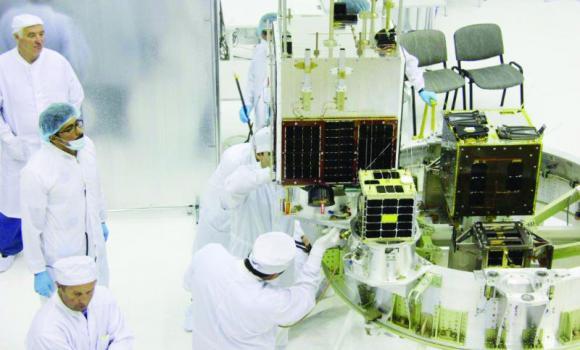
KSA marks 30 years of space research
Saudi Arabia has over the past decade through King Abdulaziz City for Science and Technology (KACST) designed and manufactured 13 satellites, demonstrating its expertise in the field developed since 1985.
The Kingdom also established a research center to study the Moon and planets in our solar system in cooperation with the National Aeronautics and Space Administration (NASA) and the Tamyuz Center for Joint Aviation and Space Research at Stanford University.
Since the 1985 flight of Discovery STS-51G, which had on board Prince Sultan bin Salman, the first Arab and Muslim to fly into space, the Kingdom has made significant progress in the space and aviation field.
It has launched the satellite, Saudisat-4, considered the first of a new generation of such machines, carrying high-tech sensors to measure gravitational forces out in space, a local daily reported.
KACST has refined its production processes to produce satellites quickly and at low cost. They can be used to test new systems out in space, including telecommunications, and energy and data storage.
This month in 1985 marks the 30th anniversary of the Kingdom’s entry into space with Prince Sultan’s flight on Discovery. The trip had a positive impact on research and development.
Subsequently, the KACST set up the Saudi Center for Remote Sensing, which is the nucleus of its space research and began its cooperation with NASA through the Challenger Space Shuttle to research the Empty Quarter Desert.
The Kingdom then established the National Program for Satellite Technology and Aviation Technology, the Center for Geographic Information Systems and the Center for Digital Studies.
KACST has developed a comprehensive national strategy for science and technology and established specialized departments at several universities to offer courses in space and mechanical engineering.
These institutions include King Fahad University of Petroleum and Minerals, King Saud University, King Abdulaziz University and King Abdullah University for Science and Technology. There are plans for these universities to produce research in the field.
The Kingdom also established a research center to study the Moon and planets in our solar system in cooperation with the National Aeronautics and Space Administration (NASA) and the Tamyuz Center for Joint Aviation and Space Research at Stanford University.
Since the 1985 flight of Discovery STS-51G, which had on board Prince Sultan bin Salman, the first Arab and Muslim to fly into space, the Kingdom has made significant progress in the space and aviation field.
It has launched the satellite, Saudisat-4, considered the first of a new generation of such machines, carrying high-tech sensors to measure gravitational forces out in space, a local daily reported.
KACST has refined its production processes to produce satellites quickly and at low cost. They can be used to test new systems out in space, including telecommunications, and energy and data storage.
This month in 1985 marks the 30th anniversary of the Kingdom’s entry into space with Prince Sultan’s flight on Discovery. The trip had a positive impact on research and development.
Subsequently, the KACST set up the Saudi Center for Remote Sensing, which is the nucleus of its space research and began its cooperation with NASA through the Challenger Space Shuttle to research the Empty Quarter Desert.
The Kingdom then established the National Program for Satellite Technology and Aviation Technology, the Center for Geographic Information Systems and the Center for Digital Studies.
KACST has developed a comprehensive national strategy for science and technology and established specialized departments at several universities to offer courses in space and mechanical engineering.
These institutions include King Fahad University of Petroleum and Minerals, King Saud University, King Abdulaziz University and King Abdullah University for Science and Technology. There are plans for these universities to produce research in the field.
Share:
ADD TO EYE OF Riyadh
MOST POPULAR
Regulations of Trade Names, Commercial Register Laws approved
Thursday 3 April, 2025 1:00New real estate measures to support household spending, private sector: Minister
Thursday 3 April, 2025 1:35New commercial register, trade names laws effective as of April 3
Thursday 3 April, 2025 1:17Crown Prince’s directives on real estate sector to curb inflation
Thursday 3 April, 2025 1:37LCGPA adds 116 products to mandatory list of national products
Thursday 3 April, 2025 1:19 ×



























